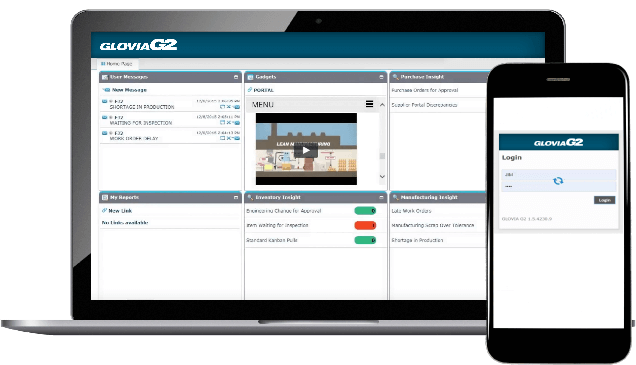Our ERP implementations have always followed a guiding principle to provide immediate value to the customer while also ensuring that we achieve the highest level of expectations.
Examples of these metrics are:
- Meeting go-live objectives — on time and on budget
- Deliver solution fit to customer requirements
- Manage scope of the overall project, both macro and detail level
- Minimizing risk
- Delivering best-in-class business consultation
- Delivering industry leading process improvements
- Limit customization and attempt best use of package ERP implementation
- Effectively empower the customer user community
All of these attributes lead to a major business benefit to our customers: the transfer of ownership of both the GLOVIA G2 system and the new and improved processes to our customer’s employees. Our objective is to provide a successful ERP implementation — however measured.
The GLOVIA G2 ERP system architecture is designed for scalability, easy implementation and rapid deployment. Our site-by-site ERP implementation allows a gradual evolution of information systems without requiring complete systems replacement, minimizing business disruption and controlling implementation costs.
We offer proven conversion procedures for a variety of legacy MRP, MRPII, & ERP systems, including MAN-MAN Classic, Mapics, and BPCS, among others.
The basis of CrescentOne ERP’s implementation services is built on a combination approach: a very strong 11-step implementation methodology coupled with utilization of customer resource and subject matter expertise.
The benefits of the CrescentOne ERP implementation methodology are:
- Secures management involvement, governance and oversight
- Controls project costs and schedules
- Provides a high degree of project visibility and documentation
- Provides a system and business process architecture and platform that will support future improvement initiatives
- Limits risk
Implementation Phases of core GLOVIA G2
Phase 1: ERP Implementation Planning and Organization
- Establish customer/CrescentOne project management process and team
- Collate all background information and documentation
- Confirm the business objectives for the project
- Develop macro and micro plan for implementing GLOVIA G2
- Develop plan for supporting technology infrastructure and deployment
- Provide first level education to user and technical team members
- Confirm Customer Business Unit representatives participation and involvement
- Confirm CrescentOne Professional Services staffing and plans
Phase 2: Hardware and Technology Infrastructure
- Acquire necessary hardware & network required
- Test and QA user response time and network loading
- Establish support model
Phase 3: GLOVIA G2 Solution Definition to Requirements
- Project team attends GLOVIA G2 education and training sessions
- Team members practice with GLOVIA G2 and develop internal customer knowledge and skills
- Team designs, develops and refines new business processes where required
- Customization requirements are identified for development
- Decisions and conversion definitions for data mapping are provided
- Business flows and desktop procedures prepared, validated and documented for use in later project phases
- Expose solution to the extended user community
Phase 4: Data Migration
- Map legacy system(s) data to GLOVIA G2 data schema
- Use the GLOVIA G2 application EIF module and application adaptors to load programs or prepare custom programs
- Prepare one-time programs to extract and format legacy data for the GLOVIA G2 load programs
- Prepare one-time data load and field initialization programs, including all required parameters
- Identify old, inaccurate, obsolete legacy data to be improved or eliminated before conversion
- Assign teams to cleanse data
Phase 5: Customization & Interfaces
- Customization requirements: special forms, custom reports, interfaces and customization are developed
- Provide technical programming skills to tailor the GLOVIA G2 application software to meet unique customer requirements
- Design and write specifications for customizations
- Make changes to programs following customer change control procedures
- Execute unit tests and QA scripts and correct as necessary
- Provide ongoing support during conference room pilot and integration test phases
Phase 6: Conference Room Pilot
- Test, demonstrate and validate the GLOVIA G2 ERP solution
- Test; verify all setups, data migrations, processes and customizations
- Prove the GLOVIA G2 ERP solution meets the business requirements
- Resolve all issues, make necessary corrections before continuing
- Repeat the conference room pilot, if warranted, to prove the changes and the total solution
- Final Customer Executive decision for go-live phases
Phase 7: Integration Test
- Conduct an integration test as a “dress rehearsal” for go-live
- Validate all solution deliverables
- Assure all elements required to execute the conversion and loads system are in place and available
- Select and train an extended user team to conduct the final testing
- Validate that GLOVIA G2 fits the business requirements and can be used to run the business
- Make any required last minute, minor changes
- Confirm the go-live date
Phase 8: Readiness Activity
- Project team and the business prepare for the go-live
- Final conversion and startup schedules are refined
- Changes in user procedures and documents for training are completed
- Deliver training to the extended user community
- Dates and schedule for cutover and implementation are communicated throughout the organization
Phase 9: Conversion and Cut-Over
- A production environment for new system is initialized
- All data is converted and loaded into GLOVIA G2
- The team executes the detail conversion schedule with all validation steps to assure complete and correct data is loaded
- Customer does final month-end close on legacy system
- Final infrastructure changes are made
- Legacy system(s) is restricted to inquiry only
Phase 10: Go-Live Support
- When conversion is complete the new system is ready for production use
- User, IT and CrescentOne support teams provide round-the-clock on-site support for the new system
- Any issues are logged and resolved as reported
- For the first weeks, the user, IT and CrescentOne team support the startup
- Help desk receives calls, resolves as many as they can; remainder is given to project team members to resolve on a priority basis
- Support continues through the next ‘x’ months’ end close cycles-where ‘x’ is to be mutually agreed
Phase 11: Post-Implementation Audit
- Evaluate the progress and effectiveness of the GLOVIA G2 ERP solution
- Review the operational effectiveness of the system as implemented
- Identify problems, performance or process issues
- Identify what is working well
- Review opportunities to further improve effectiveness with the users
- Eliminate short-term problems and obstacles
- Present a plan of longer term corrective actions and improvements — if required
Contact CrescentOne to learn more about implementing our GLOVIA G2 manufacturing ERP at your company.
Contact Us









